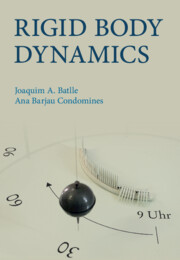Book contents
- Rigid Body Dynamics
- Reviews
- Rigid Body Dynamics
- Copyright page
- Contents
- Preface
- Abbreviations
- 1 Particle Dynamics
- 2 Interaction Forces between Rigid Bodies
- 3 Mass Distribution
- 4 Vector Theorems
- 5 Work–Energy Theorem
- 6 The Method of Virtual Power
- 7 Lagrange’s Equations
- 8 Introduction to Percussive Dynamics
- Bibliography
- Further Reading
- Index
6 - The Method of Virtual Power
Published online by Cambridge University Press: 21 March 2022
- Rigid Body Dynamics
- Reviews
- Rigid Body Dynamics
- Copyright page
- Contents
- Preface
- Abbreviations
- 1 Particle Dynamics
- 2 Interaction Forces between Rigid Bodies
- 3 Mass Distribution
- 4 Vector Theorems
- 5 Work–Energy Theorem
- 6 The Method of Virtual Power
- 7 Lagrange’s Equations
- 8 Introduction to Percussive Dynamics
- Bibliography
- Further Reading
- Index
Summary
The method of virtual power is a powerful tool to obtain the equations of motion and the constriant forces and moments in multibody systems (especially in planar motion). The d'Alembert torsor of inertial forces is defined, and then the concept of virtual motion is introduced. Numerous examples illustrate the application of that method to different mechanical systems.
- Type
- Chapter
- Information
- Rigid Body Dynamics , pp. 406 - 462Publisher: Cambridge University PressPrint publication year: 2022

